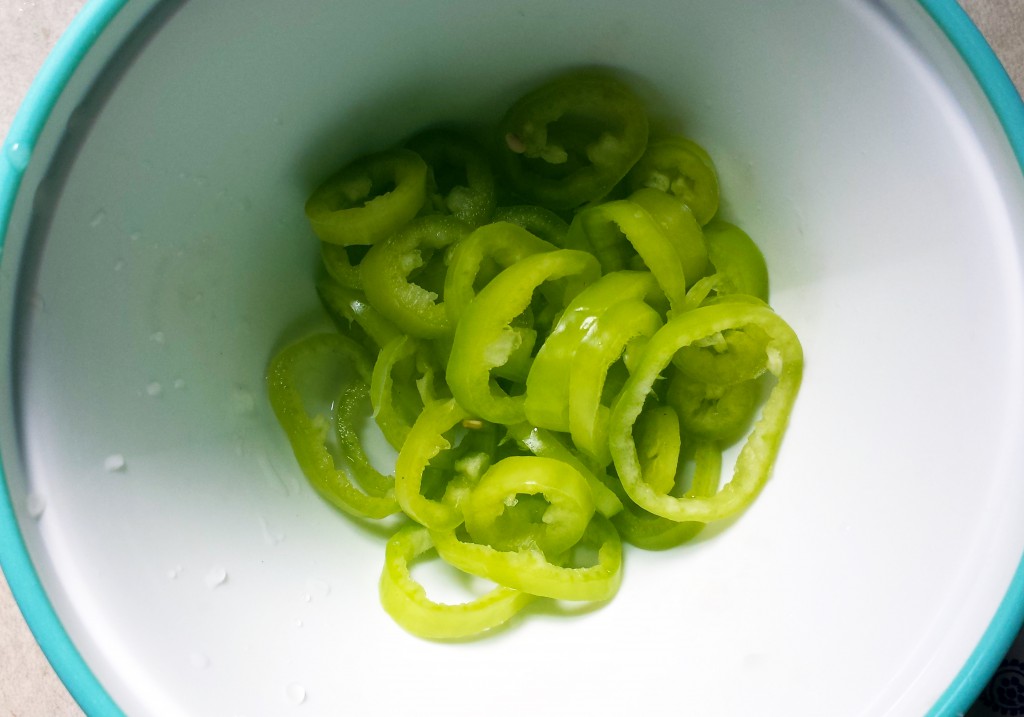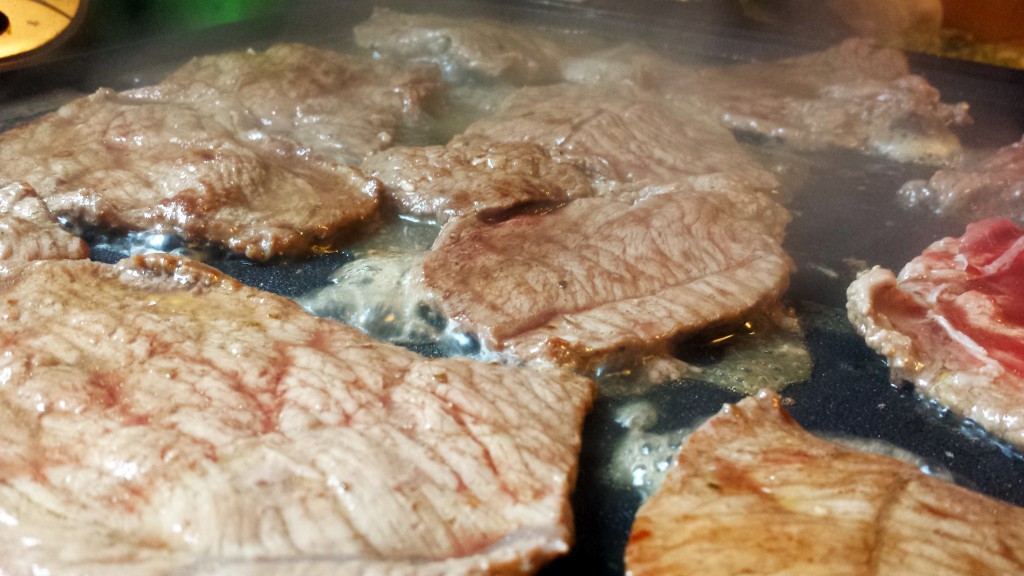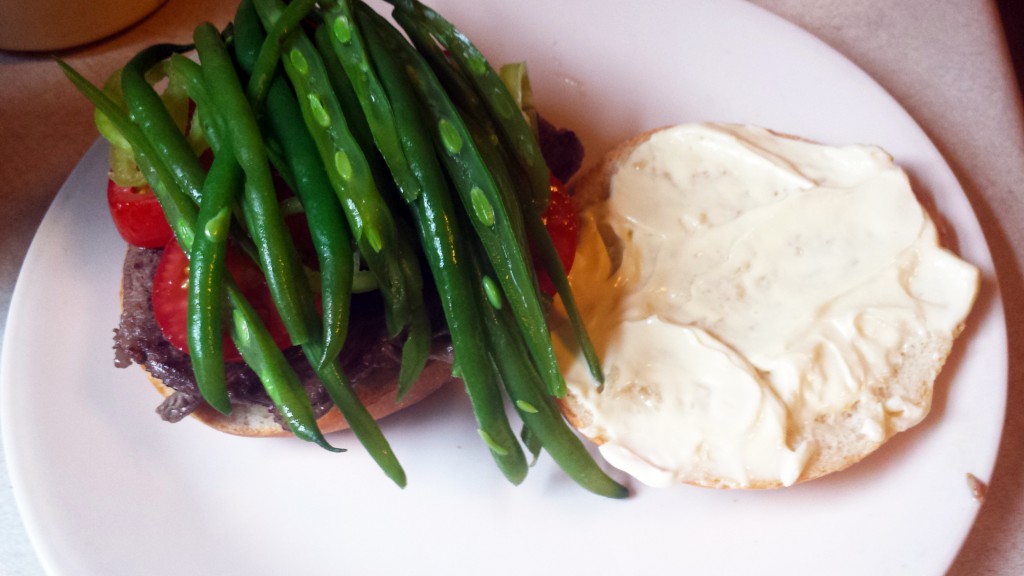The Chilean Chacarero
Let me tell you something about green beans. Green beans are my Kryptonite.
I have never been able to eat them. My mom has some kind of theory about this–she says I liked them when I was very young but that my paternal grandmother cooked them for us once and from then on, I hated them. Grandma B was a notoriously atrocious cook, even though I’ll always miss her bizarre clumpy cinnamon-flavored spaghetti sauce and her thick, pasty country gravy and the eggs that she’d cook in those weird triangular molds–they were an integral part of my childhood, terrible or not, and one taste, one smell will put me back in that tiny house in Taylorville, IL, 30+ years ago. But something she did to those green beans caused me to hate them for decades.
Or maybe that was spinach, I forget. (Spanakopita solved the spinach problem for me 20 years ago)
Anyway, I refused to eat green beans as a child; that is, I tried to refuse to eat them. Unfortunately, my mother was more stubborn than I was. She would always load my plate with them, and refused to let me leave the table until I finished. We’d sit in mute opposition, long into the evening, before I’d finally relent and eat the cold canned green beans and then go vomit them back up. I tried to convince her I was allergic but she wasn’t having it. She’d cook the green beans, I’d eat the green beans, my stomach would reject the green beans, and the porcelain would receive them.
I’m a 44 year old man now and I’m still mad about all the green beans I had to eat as a kid. About 10 years ago though, I decided that I should quit being such a baby about it. Now, when I’m at a family Thanksgiving or a Christmas dinner and somebody has brought a green bean casserole, I don’t loudly complain about the green bean smell anymore, or conspicuously move to the far end of the table, or refuse to pass the casserole and generally make an ass of myself. Instead, I’ll put a small amount on my plate and make a really dramatic production of holding my nose and forcing myself to eat it, because that’s the mature thing to do.
I bring this up because one of our sandwiches this month, the Chilean Chacarero, involves green beans. Has the list finally thrown me a sandwich I won’t eat?
Don’t be silly. I’ve never met a Chilean sandwich I didn’t like. Barros Jarpa? Delicious. Barros Luco? Amazing. There are several more we’ll be covering in the months and years to come, and I always look forward to them, as I have seen the passion Chileans have for sandwiches.
Chacarero, according to Wikipedia, is made with steak, tomatoes, chilis, and green beans. Alternately, it can be made with lomito, which means pork loin. Lomito is also the name of another Chilean sandwich that’s not currently on the List, but since we won’t get to the Ls until early 2017, that could easily change between now and then. Such is the magic of Wikipedia.
The word Chacarero is derived from the Spanish chacra, which is a word for ranch or farm. So it can be directly translated as “rancher” or “farmer,” and with all the meat and veggies on this thing, with the sheer size of this thing, either translation makes sense.
Green beans, though. Why did it have to be green beans?
The internet is pretty full of information about this sandwich, for a change. In 2014, Time Magazine called it one of the 13 most amazing sandwiches in the world. Youtube is full of videos about making Chacareros (most of them in Spanish, which I don’t speak, but the pretty pretty pictures get the point across). Bloggers are crazy about them. Boston has a restaurant named after them. This time I’d be pretty well-informed going in, and in fact much of what I’ve learned previously about Chilean sandwiches would be helpful here.
For example, the pebre sauce and pan amasado bread rolls I made for my Barros Luco post. Mayonnaise and avocado seem to be the common condiments for the sandwich (especially mayonnaise; Chile is the third highest per capita consumer of mayonnaise in the world and if you watch the videos I linked to, they really pile it on), but the pebre seemed like it would be tasty. And, at least in the Chilean videos I saw, pan amasado is a pretty common bread choice.
So I started there, with the bread. I baked some pan amasado rolls using a slightly different recipe this time, combined from a few different amasado recipes I found online and even one for hallullas, Chilean biscuits that use a yeasted, larded dough seemingly very similar to that of the amasado. (In fact, hallullas look just like pan amasado to my untrained eyes, and they could be that these are two words for the same thing. I think the main difference, if there is one, is that hallullas are rolled out and cut like biscuits instead of being shaped like bread rolls.)
Pan Amasado
Ingredients
- 1 pkg yeast
- 2 oz warm water
- 1 tsp sugar
- 3/4 C milk
- 1 tbsp lard
- 4.5 C flour
- 1 tbsp salt
- 1/2 C warm water
Instructions
- Combine 2oz warm water w/ yeast and sugar, set aside
- Heat milk and lard in saucepan to melt lard, remove from heat once melted
- Add flour and salt to mixer bowl. add yeast mixture. start mixing w/ dough hook on low
- Add milk/lard mixture, continue to mix on low
- Slowly add as much warm water as needed to bring dough together.
- Bump mixer up one notch and let knead for 9 minutes
- Allow to rise, covered, for 2-3 hours, until doubled in size
- Punch down. roll into cylinder.
- Pull in roughly equal handfuls off one end of the cylinder. You should end up with 10 or so.
- Pinch, roll, and shape dough into balls.
- Using fingers, smash balls down into flattened shape. Cover for second rise, 30-45 minutes
- Punch holes in each roll with a fork. Bake at 400 for 20-25 minutes or until nicely browned
Notes
I also made some more pebre sauce, some homemade mayonnaise, and mashed up an avocado with a little olive oil and salt to make a condiment Chileans call palta.
In one of the Youtube videos I watched, the Chilean chef Pilar Rodriguez marinated her steak for the Chacarero using a “Merken” olive oil. Intrigued, I looked into this–merken is a spice mix commonly used by the indigenous Mapuche culture in Chile, consisting of smoked goat horn chili, sea salt, cumin and coriander. This sounded like a great idea to me, and though I could have ordered some Merken olive oil from Amazon, I thought I’d try making an approximation using ingredients I had on hand. I used about a 3:1 ratio of extra virgin to light olive oil, added dried ancho & pequin chiles, cumin & coriander, and simmered them over low heat on the stove for about an hour. Then I drained the oil, let it cool off, and made it into a marinade with lime juice, red wine vinegar, garlic, kosher salt, and oregano.
I used this mock merken marinade on some steak and some pork. Why choose which meat to use when I can make sandwiches with both?
The sandwich also calls for tomatoes, so I sliced up and salted some of my winter standby tomatoes, Camparis (not just the name of an Italian amaro!).
The chiles used in the Chacarero videos I saw most closely resembled banana peppers; though unlike banana peppers, they appeared to have at least a bit of heat. (Chilean cuisine is not capsaicin-heavy but it’s not devoid of spice either) I bought Hungarian wax peppers, since they have a similar shape and color to banana peppers with a Scoville rating roughly equivalent to jalapenos.
For the green beans, I cut off the stem ends, then simmered them in a covered skillet with a 1/2″ of salted water for about 2 minutes. When they were done, I shocked them with an ice water bath to stop them cooking (don’t want mushy green beans. Hell, I don’t want green beans at all!) and split them in half lengthwise.
I reheated some amasado rolls in the oven, opened them with a bread knife and spread some butter on them. Nothing left to do but cook some meat and make some sandwiches.
For the steak, I remembered what Francisco from Bay Essence had told me about filete, a word for sirloin steak that in the Chilean dialect also means the best of the best. I bought some thin-sliced sirloin and pounded it thinner yet before cutting it into smaller pieces and letting it marinate briefly.
I cooked them on an electric griddle (a la plancha! another lesson from Francisco) over medium-high heat, until nicely browned but still juicy. I made two sandwiches, one with mayonnaise and one with avocado.
I cut these sandwiches in half to split them with Mindy, but also to get a nice view of the cross section.
To be honest, I’d been absurdly excited about trying these sandwiches, despite the green beans. And when it came down to it, whatever it is that turns me off about green beans, I just didn’t detect it in these sandwiches. There’s a variety of textures and tastes going on. There’s the bread, warm, crusty, a bit salty and dense. The steak, hot, chewy but tender, meaty and savory with a bit of sour/salty from its quick swim in the marinade. The tomatoes are juicy; the chilis add a little heat and crunch; the green beans are crisp and grassy but mild enough that I did not immediately run to the bathroom and hurl. Nobody was more shocked than I.
Mindy was wild about the sandwich with the avocado, but I thought the mayonnaise actually worked better in this combination, especially once I’d added some pebre sauce. My homemade mayonnaise has a nice tartness to it from citrus and vinegar and helps dress the veggies better, in my opinion, than the avocado. Perhaps if I’d added some lime juice to the avocado it would have worked better, but even with the pebre it just came off as blander. She finished the half with the avocado, but left the mayonnaise half for Damian (who wondered aloud where the heck was his avocado!).
For the pork loin, I poked a few dozen holes through it with a steak knife to let the marinade get in quicker, then marinated it at room temperature for about 2 hours. I used my 12″ cast iron skillet with a bit of vegetable oil over high heat to sear the roast all over, then finished it in the oven at 375 for 25 minutes or so, until the internal temperature reached 140 degrees. (The USDA recommends 145 but pork loin is a lean meat and can easily overcook & dry out. Nobody wants a pork jerky sandwich). I rested it under tented foil for 10 minutes, then sliced into it.
Neither the 14yo nor the 8yo were into the idea of these sandwiches, and I didn’t need the whole roast for the Chacareros anyway, so I sliced up some pork to serve for dinner, with steamed green beans and some crusty Italian bread. Mindy had a plate and says that from now on, I need to cook her a pork loin for dinner every Sunday night. Come on though babe, I know the pork was great but it’s all about the sandwiches. Those kids are missing out.
Again, I cut these sandwiches in half to share.

The pork was moist and delicious but had a less assertive flavor than the sirloin steak. Thus these sandwiches were more of a showcase for the vegetables and the condiments. Again, I preferred the mayonnaise to the avocado, though both were great. This time, Damian also got to try the avocado but ended up agreeing with me that the mayonnaise worked better.
You should eat this sandwich. Look at it again. It’s so beautiful and colorful. It’s practically art. How can you resist?
You should eat this sandwich. With all these vegetables, it’s probably good for you somehow.
You should eat this sandwich. I don’t know what more convincing argument I can present than this: Chile’s sandwich game is so strong that it got me to reverse a lifelong aversion to green beans. I’ve eaten six of these over the space of three days and I want more.
Go on. Eat it. You know you want to.
UPDATE: Ignacio Molina, the Chilean journalist who interviewed me previously, is arguing against my use of pan amasado for this sandwich, claiming that marraqueta is the only bread that can be used for this sandwich and that my sandwiches are a monstrosity, an aberration, a mutation that should never have seen the light of day. Clearly, I don’t understand Chilean cuisine as well as I thought.

I like sandwiches.
I like a lot of other things too but sandwiches are pretty great






















Awesome. I went through a similar green bean experience as a kid. Loved green beans early on, but it all went wrong somewhere, and I couldn’t stomach them for a long time. I don’t remember when I started liking ’em again, but I’m guessing it had to do with eating fresh green beans. I’ll snack on some fresh green beans like they’re potato chips. I’m looking forward to eating this sandwich.
awesome , As a Chilean American that spend the first 20 years of his life in Chile i think you have a very good grasp of our addiction to sandwiches. As i read your post and saw the pictures my mouth watered (going home and i will make some). I do agree that the Marraqueta bread is the best bread for this sandwich but the original was in fact made on pan amasado. (this was the workers sandwich made with things they had available in the farm, marraqueta is a city bread not readily available in the country side). and for the green beans i find my self not liking the regular cut , but the french cut that is commonly use in chile changes the experience.
Oh man, as a Chilean I’m thrilled to see your dedication here. I love the ‘Aji verde’ (banana chili) and not so much the green peppers.. and I’m not a big fan of green beans (I hate when they taste like chewing water).
Anyway, just a few smuggy corrections if you allow me… The chacarero usually goes with beef, and without avocado, and another classic is the “lomito italiano” which is pork just like you did, with avocado, tomato and homemade mayo.
and my personal favorite is a barros luco (beef and cheese) plus tomato and aji verde.
Nice blog by the way,
Cheers
Why did I say green peppers? I meant just the green beans
We’ve got Italiano coming up soon on the List! Barros Luco and Barros Jarpa were among the first sandwiches we covered. I really love Chilean sandwiches and I’m glad to hear you enjoyed our take!